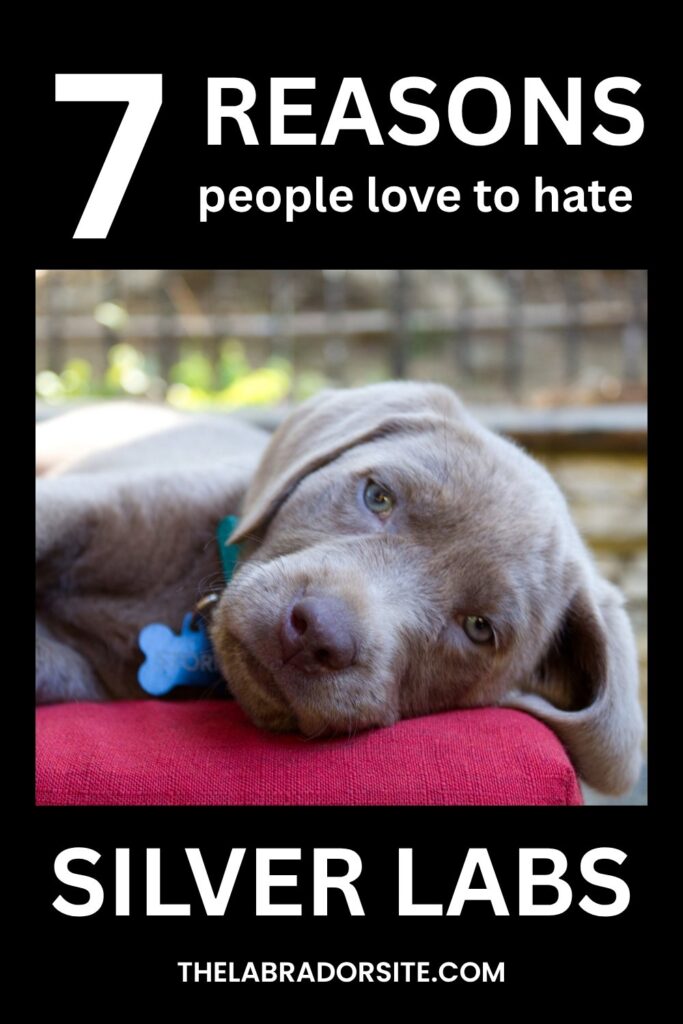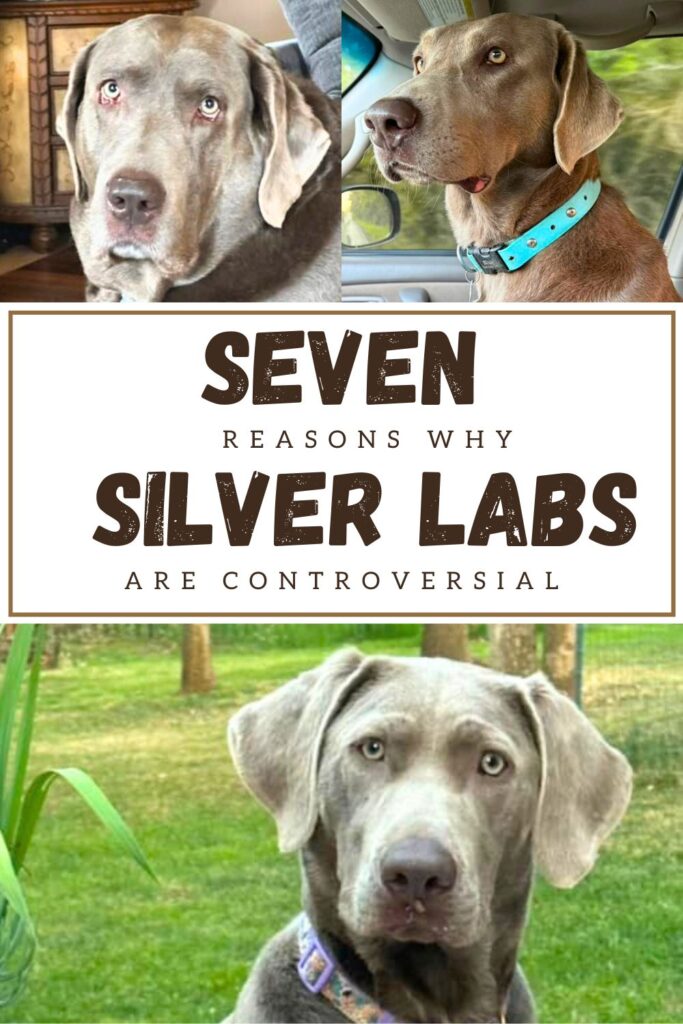7 Reasons People Dislike Silver Labs
The first thing to say is that this is not an in-depth report on the myths and mystery that surround the history of the silver lab and its arrival in the Labrador owning community. If it’s ‘in-depth you are looking for, you’ll find that on this page, (it’s quite a long read so grab a coffee first!)

Not everyone has half an hour to spare to wade through that kind of detail so what you’ll find here is a summary of the main arguments (and counter arguments where appropriate) about silver Labradors. And lots of lovely photos of our readers’ gorgeous silver Labs

Some of the arguments are simply opinion. What people like or don’t like to look at, how people believe dogs should be bred etc. Others are based on beliefs. Sometimes those opinions and beliefs are based on a false premise. And where that’s the case, I’ll discuss it.
7 Reasons people hate silver Labs
Hate is a strong word. But if you own a silver Labrador the chances are you’ve been on the receiving end of some pretty unpleasant verbal attacks. And silver Lab owners tell me that they struggle to know what to say when harangued about their dog and even told in no uncertain terms that their dog isn’t a Labrador at all.

If that’s happened to you, I hope these reasons, and the information below each one, will help you understand and respond if you want to.
Most people who are offended by the existence of silver Labs don’t hate the individual dogs. But they do hate the fact that silver Labs are here to stay, and are being registered by the AKC and purchased by puppy buyers. Here’s why.

Reason #1 They believe silver Labs are mongrels
Some people believe that silver Labs are mongrels and are not purebred Labs at all. And therefore that the people buying them are foolish or ignorant and have been tricked.
Response:
This argument is still being debated. There are now many Silver Labs registered with the AKC (they are registered as chocolate) and many people have had their silver labs DNA tested with a ‘purebred Lab’ result.

If the AKC, with all their wealth and resources, could prove that Silver Labs were the result of mixed breeding they would not be registering them. But they can’t. You can read more about the history behind this debate in my main report on silver Labs
Reason #2 They think silver Labs look like Weimaraners (so they must be a Weimaraner cross)
Silver Labs are made possible via a gene that dilutes the color of chocolate fur. It’s possible that the dilute gene got into the Labrador breed via a Weimaraner after the pedigree registers were closed. Either accidentally, or mischievously.

That striking silver coat in a large dog is definitely reminiscent of a Weimaraner. And some of the early Silvers had quite houndy appearances.
Response:
It is entirely possible that the first Silver Labs were Weimeraner mixes. It is entirely also possible that they were not.

Many Labs from working lines, which is where Silver labs first appeared, have a houndy appearance and don’t really meet the breed standard. That’s because people breeding labs for Field Trial success or as hunting companions, focus their breeding efforts on ability, not looks.

It’s also possible that the dilute gene was there in Labs all along, or got into the breed via a Chesapeake Bay Retriever – another breed that permits the dilute gene, and that has been worked and bred alongside Labs for generations. Bear in mind that not so long ago, cross breeding between breeds was normal and permitted.

Reason #3 They believe mix bred dogs are inferior
If the dilute gene was introduced into the breed via another breed after the pedigree registers were closed then strictly speaking Silver Labs are mixed breed dogs. And a belief that mixed breed dogs are inferior is common in dog breeding circles.
Response:
In fact, purebred dogs are quite a modern phenomenon. And high quality dogs with a consistent appearance and traits, have existed for hundreds of years.

The Labrador was recognised as a breed in 1903 and at the point a breed is established, or soon after, is the point at which breeding becomes restricted to matings between dogs registered to that breed. Yet the Labrador dates back well before the twentieth century when outcrossing to other breeds was common.
At that time membership of a breed was determined by appearance and abilities. Not by parentage.

My view is that there is no inherent virtue in being purebred, it’s rather like being a member of a fancy club, only far more damaging because of its impact on the gene pool.
There are advantages to buying a purebred dog such as predictability of appearance and character traits. But there are disadvantages too.
Reason #4 Silver Labs don’t meet the breed standard.
This is true. Silver Labradors do not meet the breed standard. The Labrador breed standard states there are three colors allowed. Black, Yellow and chocolate. But what does this mean for the owner of a Silver Lab?
It means you won’t be able to enter your dog in an AKC recognized dog show. So you can never win Best of Breed at Westminster, no matter how handsome your dog is.

Does it mean anything else? Well this is where opinions come into it
Opponents of Silver Labs believe the breed standard is very important. And furthermore, that it offers protection to the puppy buyer. Here is a quote from someone discussing this on Reddit “Breeding to meet breed standards ensures the dog is healthy and has correct temperament.”
Response:
This belief is very common. Sadly this is completely untrue. Many breed standards require debilitating body shapes and seriously disadvantage the dogs that meet them.
French bulldogs for example, where the breed standard requires a muzzle length that reduces a dog’s ability to breath easily. Or dachshunds where the breed standard requires disproportionately long spine that greatly increases the risk of painful spinal diseases. These standards are drawn up by breed clubs, and are not required by law to be subjected to regular scrutiny by a veterinary body. The clubs themselves are represented by the AKC or in the UK by the original Kennel Club which are the trade bodies for all the dog breed clubs.
The breed standard is a guide and in some breeds it is a reasonable one. But it is in no way a guarantee of health and correct temperament. Only ethical, responsible, breeding can truly offer some assurances for a puppy buyer. (see How To Find A Responsible Breeder)
Reason #5 They believe Silver Lab breeders are unethical
There is a general belief among purebred purists that all Silver Lab breeders are unethical, and irresponsible. This is probably the most common argument I hear.
Response:
This seems to be an unjustified stereotype. Finding a responsible breeder is critical if you want to buy a puppy with a better chance of good health, but irresponsible breeders can be found in every breed, and in every color or variation of that breed.
Let’s face it. Anyone can breed from a dog. Whether mixed breed or pure breed. You do not have to pass any kind of test, or be registered or inspected (unless you are breeding at scale)
You might suspect that a purebred breeder that competes in the show ring and has a reputation to uphold would be a more responsible breeder than someone who has no interest in showing and breeds a litter of Labradoodles in their kitchen.
And you might be right. But in fact I have seen no evidence to suggest that silver Labrador breeders are more likely to be irresponsible than any other dog breeder. And I have met unethical and irresponsible dog breeders, who adhere strictly to breed standards.
So the onus is on you as a puppy buyer to find a responsible breeder. If you take care to ensure that the parents of your puppy have been thoroughly health tested, then you have made a good start.
Plenty of silver Labrador breeders carry out these tests, but you must do your homework when you look for one, just as you should with a puppy of any color or breed. ( see Choosing The Right Dog)
Reason #6 Silver Fur Is Less Healthy
The dilute gene that changes chocolate fur to silver, is not limited to chocolate fur or to Labradors, Chesapeakes, and Weimaraners . And in some breeds the dilute gene is associated with hair loss.
This is known as color dilution alopecia. And the existence of this hair loss issue is one argument for eliminating the color dilution gene from the Labrador breed.
I hasten to add that no-one is suggesting we eliminate any dogs, just that we stop breeding from Labradors with the dilute gene.
Response:
Color dilution alopecia is well documented in Dobermans but incidences have been found in other breeds with blue or silver coats, including silver Labradors. This doesn’t appear to be a widespread risk, and most silver Labs have healthy fur and skin. But it is a risk. And it is something you might want to consider.
Affected dogs start to lose fur as they mature and the condition is progressive. While not life threatening, color dilution alopecia spoils the appearance of the dog, may be itchy, and makes the dog vulnerable to sunburn. Because the condition is inherited, careful breeding should be able to eradicate it from a particular line of Labs, given time.
Reason #7 They believe silver Labs are overpriced
Silver Lab opponents believe that silver puppies are outrageously overpriced. And that the price should reflect that fact that these dogs do not meet the breed standard, even if the AKC has registered the puppies.
They feel that the price of a dog should reflect the status of the breeder as someone who meets the breed standard and that the silver Lab, which they consider to be mixed breed, is of lower value.
Response:
When a type of dog becomes popular, prices go up. And they keep going up until supply meets demand, then they tend to level out.
This rise in price is common when a new breed or mixed breed becomes fashionable. We saw it in Labradoodles (a mix breed), but also in French Bulldogs (a pure breed) when demand rose. With puppies of both breeds going for many thousands of dollars.
These things tend to level out in time. In the meantime, if the going rate for a particular type of dog is five thousand dollars, it would not be logical for an individual breeder to charge half that.
Of course you could argue higher prices attract breeder who are looking to make money. But so do well paid jobs. Taking pleasure in earning money, does not in itself make the person selling a product, or applying for a well paid job, unscrupulous. Though of course, they might be.
What is unscrupulous, is trying to justify high prices by making dishonest statements or claims. So you might want to avoid breeders that claim their silver puppies are ‘rare’ or ‘unique’. They are not.
Ultimately, if you want a popular dog, you’ll probably pay a higher price. Especially if demand exceeds supply. Just don’t be tempted to cut corners on health checks in order to bring the price down. Better to pick a different breed.
Personally I think many puppies are too cheap. I don’t think a dog should ever be an impulse buy but should reflect the commitment and effort that is involved in raising and caring for them. But that’s just me.
Disclosure and more information
For full disclosure I can confirm that I do not own a silver Lab. I prefer the yellow and chocolate varieties of the breed, and so I probably would not buy a silver one even if they were widely available here in the UK, which they are not.

The reason I support owners of silver Labs in some of these counter arguments, is because I think that many of the arguments against these dogs are spurious.
And for good measure, even if silvers are not pure, that’s fine with me because I believe that breeding for type and traits without the barriers of a closed register would benefit all purebred dogs.
For more information on the long term consequences and harm from breeding dogs in isolated gene pools you might want to read this article : The Facts About Purebred Dogs And Inbreeding
Don’t let the haters get to you
We all love our dogs. And all dogs are equally valuable members of our community. No matter what color they are. Or who their parents are, or what bit of paperwork came with them.
The AKC’s willingness to register generations of Silver Labs (albeit as chocolates) mean the dilute gene is here to stay. It really doesn’t matter whether it came from Weimaraners, or Chesapeakes, or was there all along. It’s here now.
If you would love to own a silver Lab, do the proper checks, ask the breeder about the incidence of color dilution alopecia in her lines, make sure the parents have good hip and eye scores and all the health clearances that currently go with the breed.
Buy a puppy from friendly parents and socialize it thoroughly. Then go ahead and enjoy your beautiful dog. And don’t let the haters get to you.

Free Labrador Updates!
Get my training tips, news, reviews, and the latest from The Labrador Site delivered to your inbox




What’s great about the silver Labrador? Let’s focus on the positive
I have a rescue silver. I have mainly had Labradors and grew up with them. The reason I was chosen by the rescue to have my beautiful boy was because my previous dog was a Weimaraner so I had experience with them. 🤔 I didn’t say anything as he clearly needed a stable, calm, new home and I knew I could give it to him. I have been stopped a few times with mainly positive opinions, but once I was told he should have been put down as it was detrimental to the breed and another time I was told that he was a mongrel and I was scammed. I don’t care what he is. He is my dog, we have a lovely life together and we are working hard to help with some of the damage he suffered in his early life.
Silver is not a color recognized by the Labrador parent club or the AKC standard. Labradors come in 3 colors- yellow, black and chocolate.
Nope but he’s recognized in my family & that’s all that matters !!❤️
That’s not actually correct.
Silver is formally recognized by the AKC. They used to register silver labs as silver. They switched to registering as chocolate after studying the issue, but AKC’s official position is that silver is a shade of chocolate, and when owners call to ask what color to register their silver pups, they are told chocolate.
I have a silver lab he’s 9 years old and I have never had any issues with people about him everyone has loved him and his color he’s unique and I love him